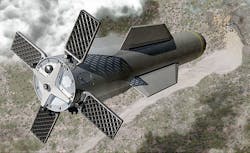Air Force asks Boeing to build bunker-busting super bomb with ruggedized guidance for deeply buried targets
EGLIN AIR FORCE BASE, Fla. – The U.S. Air Force is asking the Boeing Co. to build additional Massive Ordnance Penetrator bunker-busting super bombs under terms of a $70 million contract announced last Thursday.
Officials of the Air Fore Life Cycle Management Center at Eglin Air Force Base, Fla., are asking the Boeing Defense, Space & Security segment in St. Louis for the GBU-57 Massive Ordnance Penetrator carriage and release equipment.
The satellite-guided Massive Ordnance Penetrator, otherwise known as MOP, is a 30,000-pound super bomb with a 6,000-pound high-explosive warhead that is designed to destroy hard and deeply buried targets such as reinforced-concrete bunkers and deeply buried tunnel facilities.
In 2011 Boeing developed a modified fuse design for the GBU-57 super bomb. Boeing has developed the Massive Ordnance Penetrator at the company's facilities in St. Charles, Mo., for the U.S. Defense Threat Reduction Agency (DTRA).
The U.S. Air Force B-2 and B-52 heavy bombers carry the Massive Ordnance Penetrator for dropping from high altitudes. Boeing completed a static tunnel lethality test of the MOP munition in March 2007 at DTRA's weapons tunnel complex at White Sands Missile Range, N.M.
The Massive Ordnance Penetrator super bomb was developed amid heightening worldwide concern of the mounting capability to build and deploy nuclear weapons in countries such as Iran and North Korea that are openly hostile to the United States.
The conventional Massive Ordnance Penetrator is 20 feet long, and is designed to penetrate targets more deeply on impact than any other existing nuclear bunker-busting weapon, and then detonating its three-ton explosives payload.
Related: Northrop Grumman to help develop RF seeker for future rocket-propelled bunker-busting bomb
An explosion from the gigantic air-dropped munition is expected to penetrate as deeply as 200 feet through reinforced concrete, which is able to withstand pressure of 5,000 pounds per square inch. The bomb will burrow more than 26 feet into the ground through reinforced concrete before detonating.
As such it requires extremely ruggedized guidance, fuzing, and other on-board electronic components to survive and operate through the huge G-forces of impact from high altitude.
On this contract Boeing will do the work in St. Charles, Mo., and should be finished by April 2026. For more information contact Boeing Defense, Space & Security online at www.boeing.com, or the Air Fore Life Cycle Management Center at www.afmc.af.mil.

